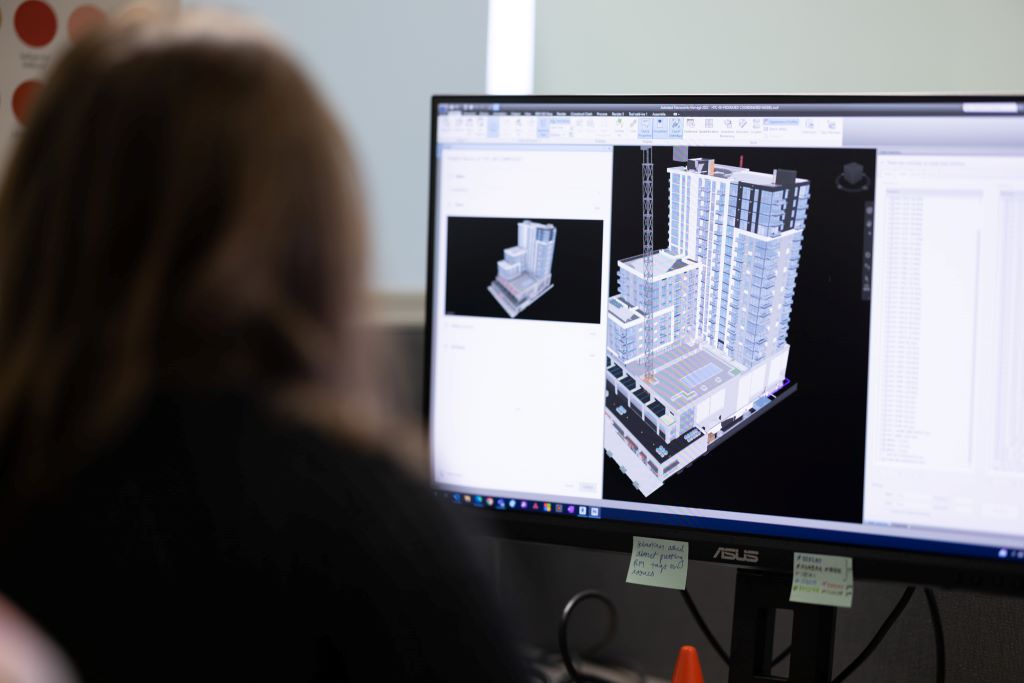
I was recently asked on a panel, how has technology changed in the construction industry. If you look at just the last 20 years, our industry has gone from using virtually no technology in our everyday work to relying on technology throughout every phase of the project. I’ve been working in construction for 20 years next year, and for my first job in the field — I didn’t even have an email address. Our industry has evolved from paper plans and hand-filled forms to entire project teams using data-driven programs to keep projects on target and improve communication. Upon reflection, I think the question I’m more interested in than how technology has changed in our industry, is how our industry has evolved by embracing technology.
Data Drives Detail
A decade ago, budgeting a project either meant not including a lot of detail or dedicating a considerable amount of time to sifting through file cabinets and notebooks to find a similar general conditions estimate and cost of work line items. Now, details that once might have been a multi-hour research project are discoverable in minutes. That’s because our technology has made capturing project data throughout the lifespan of a project almost effortless, and that information is then stored and searchable for others in the company. When we’re creating a conceptual budget for a client, we don’t have to — or want to – give estimates based on overly generalized historical data. We can instead create a budget based on how many project managers and superintendents have been required on a similar project of this type and size, how many months a phase has historically taken (broken down to cost per month), or how many subcontracts were managed? These details allow us to turn around a budget an owner can trust. There may still be some unforeseen factors that impact our proposed cost, but we’ve taken detailed aspects of their project into consideration and used data to determine as accurate a budget as possible.
Proactive Research Can Save the Day
Speaking of unforeseen factors, our industry has experienced more volatility in the last 4 years than I can remember seeing in my entire career. The sudden drastic inflation of different materials — one day it’s lumber, the next it’s steel, then it’s everything electrical — has taught us all to keep an ear to the ground. Within our company, we’ve developed a data tracking platform that allows anyone in our company to report a price increase for others to see. We’re also reporting up-to-date market trends from outside sources and providing cost analysis for our project teams. We’re not only collecting data, we’re interpreting it and using it to provide better estimates, material selection suggestions, and schedule projections for our clients and design partners. We all know bad news gets worse with time. If the design calls for a material that we discover during procurement has a significantly long lead time or has tripled in cost — that finding during construction could derail the project’s budget and/or schedule. However, if we’ve been tracking cost and supply chain data continuously and are able to provide that insight to our clients and design team during early phases of the project, we can provide comparable alternatives or other solutions that will keep the project on course.
A Picture Is Worth a Thousand Words
Clear communication is vital to the success of a project. The ability to craft visual information through business analysis tools is one of the most positive changes I’ve seen through our industry’s evolution of using technology. We are able to use these tools to convert rows and rows of data into a visually clear graphic that everyone in the room can understand. When data is more easily understood, every member of the team can analyze the data and apply it to their responsibilities. This creates the opportunity for more creative solutions and increased collaboration. Beyond that, it simply saves time. Before, a preconstruction manager might have presented slides with sheets of data tracked and then taken the time to explain what it all means. Now, a simple image can get everyone on the same page almost immediately. Shorter, more productive meetings — that’s a win for everybody.
Beyond the single image, we can use construction technology like 3-D modeling, business analysis tools, or construction planning software to provide options to clients, with thorough validation, in real time during planning or design phase meetings. If a project comes in over budget, we can use our research and data to provide a list of alternative materials and show the budget implications in real time. We can look at the project by phases or broken out by its various trade packages. There is an endless amount of specificity and detail we can provide to our client; broken down in a way that works best for them. Clearness leads to confidence; everyone is on board and more confident about the decisions that are being made.
Technology is constantly evolving. While our industry can be slow to adopt new technology and maybe even resistant to change, the technology we have adopted has driven improvement and created more value for clients. Our ability to track data is leading to more informed schedules and detailed (and accurate) budgets. New tools and software allow us to communicate more clearly and collaborate more effectively.

